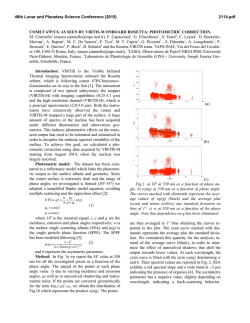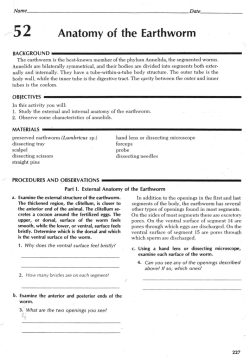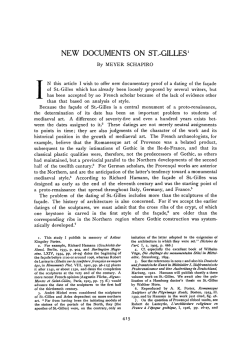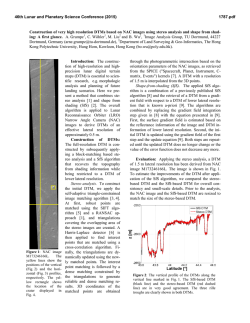
Glottidia audebarti (Broderip), (Brachiopoda, Lingulidae) from the
Rev.BioI. Trop., 38(2A): 251 -258,1990 Glottidia audebarti (Broderip), (Brachiopoda, Lingulidae) from the Gulf of Nicoya, Costa Rica Christian C. Emig* and José A. Vargas ** • C NR S- GD R n0175, Station Marine d' Endourne, Rue de la Batterie-des-lions, 13007 Marseille, France. •• Centro de Investigaciónen Ciencias del Mar y LirnfIología (CIMAR), Universidad de Costa Rica,Costa Rica. (Rec. 15-XI-1989 Acep 23-II-1990) Abstract: Specimens oí the burrowing brachiopod Glollidia audebarti (Broderip) were collected by coring lit the Punta Morales intertidal mud flat (65%sand, 32%silt + cIay) in the upper Gulfoí Nicoya (100 N,85°W),an estuaryon the Pacific coast oí Costa Rica. 1ms collection extends the present distribution oí the species írom tbe Pacific coasts oí Mexico to Ecuador. A detailed description oí the shell is provided. The .intemal muscle arrangement, not observed previously except on dry specimens, appears as intermediate between those oí G. pyramidata Stimpson and G. pal meri Dall. Deposit feeders dominate the associated fauna,and lists oí tbe ten most important species oí the macrofau na and meioíaunal groups are included. G. audebarti is an important food item for two species oí shore birds: Catoptrophorus semipalmatus and Limnodromus griseus. In the Gulf of Nicoya G. audebartico-occurs with G. albi da Hinds. Key words: systematics,redescription,morphology. The Brachiopoda, or lamp shells, are lop hophorate benthic invertebrates that are en closed in a bivalve shell attached directly or by means of a pedicle to or in the substrate (Hyman 1959). In the Class Inarticulata the valves are held together by muscles only, and its family Lingulidae includes two genera, Lingula and Glottidia. Dall (1870) created the genus Glottidia which stands out from the ge nus Lingula by the presence of septa inside the shell, two in the ventral valve diverging from the beak and a median septum in the dorsal val ve, and gill ampullae in the mantle (Figs., 2A, and 3). There are no species of Lingula known to occur in the coasts of the Americas. Specimens of a burrowing brachiopod were collected by H. Curnmings in an extensive in tertidal coarse sand environment (twenty kilo meters long and 3 km wide) at Puna Island, CIMARContribution 152 Bay of Guayaquil (Ecuador). The specimens had been originally described by Broderip (1835) under the name Lingula audebardii whi le dedicated lo the Baron J. d'Audebart de Férussac: thus, the species name had to be co rrected as did Deshayes in Lamm:ck's edition (1836) into audebarti. The short description by Broderip (1835, p.144) concerned mainly the greenish colour. in transverse lines "produced by progressive increase of the shell". From the complementary information given in the same journal by Owen (1835), only figures 14 and 15 are useful, being similar to our figure 2. Davidson (1888) in a comparison of G . audebarti and G. pyramidata Stimpson was convinced by their synonymy. Dall (1870), however, kept both species separated and later stated (Dall 1921, p. 268) "the extraordinary confusion introduced by the synonyrny with G. pyramidata". He also pointed out that the differences between both species are mainly because they come from "a different 252 REVISTA DE BIOLOGIA 1ROPICAL UNITED STATES OF AMERICA ATLANTIC OCEAN � \ \ :19¿)C) '� MEXICO . \ .,.. D � .... O � .� -o *b .c • d \,22 �.-.. � i __... ee PA CIFIC O STA Gulf of Nicoy RICA OCEAN Fig. 1. Geographic distribution of the species of Glollidia: 8. G. albida;b. G. palmeri; c. G. audebarli; d. G. semen; e. G. py ramidala. 1. Monterey; San Diego; 2. San Bartolomé; 3. Magdalena Baja; 4. Concepción Baja; 4. Concepción Baja; 5. San Felipe; 6. Mouth of Colorado river; 7. Guayrnas; 8. Topolobampo; 9. Fort Amador; 10. La Plata; 11. Guayaquil; 12. Hampton; 13. Beaufort; 14. Wilrnington; 15. Charleston; 16. Sapelo Island; 17. Jacksonville; 18. Fort Pierce; 19. Miarni, Pensacola; 20. Grand Isle; 21. Martinique; 22. Gulf of Nicoya. ( Modified from Ernig 1983, Fig.l). zoological province" (G. pyramidata from the North Atlantic coast of America). Dall (1921) also remarked that "Glottidia audebarti is a large species with the umbonal half mostly white, the distal half of the valves painted with a brilliant blue green, unlike any other species in the genus". Since Dall's paper, the only work on the systematics of Glottidia is by Emig (1983) and all the few specimens available of G. audebar ti were dry, thus precluding a c10se examination of the soft parts. The recent finding of this spe cies on the Gulf of Nicoya, Costa Rica (Fig. 1) by one of us (J.A. Vargas), is the opportunity to get a detailed description of G. audebarti and to compare it with the three other species of the genus. MATERIAL AND METHODS Glottidia audebarti was collected by coring (to a depth of 15 cm in the sediment) during a two year survey of the macrofauna (organisms > 500 Ilm) of the Punta Morales intertidal mud flat (tidal range is 2.3 m) in the Gulf of Nicoya, an estuary on the Pacific coast of Costa Rica. Specimens were originally preserved in 10% buffered formalin in sea water, and later trans ferred to vials filled with 70% ethanol. On the average sediments at the site were made of 65% sand, 32% silt + c1ay, and about 2% orga nic matter content (by combustion). The very fine sand (62 to 125 Ilm) and fine sand (125 to 250 Ilm) were the most important (by weight) sand fractions. Sediments were also EMIG & VARGAS: G/otlidia from !he Gulf oC Nicoya characterized by a thin « 1 cm deep) oxidized layer. Salinity oscillated seasonally from 24 0/00 (rainy season) to 36 0/00 (dry season), Vargas (1987, 1988). RESULTS & DISCUSSION Systematics. Broderip 1835 (p. 143-144, Fig. 17); Owen 1835 (p.157, Figs. 14-16); Dall 1870 (p.159); Dall 1921 (p.268); Davidson 1888 (p. 223227); Cooper 1977 (p. 51); Emig 1983 (p.484, Fig.8). Geographic diSiribution (see Fig. 1). 7. Guaymas (Emig 1983); 8. Topolobampo (Dalll921, Emig 1983); 9. Fort Amador (Emig 1983); Bridge of the Americas, Balboa Harbor (Cooper 1977). 11. Type-Iocality: Isla de Puna (Broderip 1835; Davidson 1888); 22. Gulf of Nicoya (Vargas 1987, 1988). The present distribution of G. audebarti ex tends from the Pacific coasts of Mexico to Ecuador. In the Gulf of Nicoya this species co occurs with G. albida Hinds: 102 specimens of G. audebarti reported by Vargas (1987) may include, however, individuals of both species. Most of the specimens collected during that first year survey were very small. The second year only five large individuals of G. audebar ti were found (Vargas 1988). The known distri bution of G. albida is thus extended southward from Monterey (see Emig 1983). The last spe cies occurring on the Pacific American coasts is G. palmeri Dall, found near San Diego and San Pedro (California) , and in the Gulf of California (Emig 1983). G. pyramidata mentio ned earlier, is the only species of the genus for the American Atlantic coasts (Figs. 1). The sta tus of G. semen (Broderip), Fig. 1, is uncertain at present. Taxonomic characteristics Shell (Fig. 2 A & 3; Tables 1 & 2). General shape: oblong-elongate; subparallel to parallel lateral margins; anterior edge slightly rounded up to nearly straight with a 253 small median angular projection in large indivi duals; external surface smooth but growth lines little marked (Fig. 3). The measurements and ratios of sorne shell characteristícs of G. audebarti are included in Table 1. The comparison with data for the other Glottidia species (Table 2) shows similar vari ability of ratíos within G. albida. G. pyrami data and G. audebarti. while more data are ne eded on G. palmeri. On Lingula shells the W/L ratio varies between 0.381 and 0.552 in L . anatina. and from 0.543 to 0.698 in L. adamsi. Colour: creamy white on the posterior half of the shell and lateral margins; bright green to turquoise in horizontal lines on the anterior half with two oblique posterior típs (Fig. 4). This shell colour is specific of G. audebarti (Dall 1921).. Deltidial regions: acute; dorsal valve with a beak profile oblique and less concave than the ventral valve; the pedicle groove (ventral val ve) with growth lines and discontínuous with the internal side of the valve, and concave beak profile (Fig. 2A). The deltidial region of both val ves shows smaller but sharper beaks than in the other species. The dorsal beak profile is rather similar to that of G. palmeri; and the ventral one is similar to that of G. albida. as well as the discontinuous pedicle groove. Septa of the ventral valve: oblique straight to slightly curved as in G. pyramidata and G . palmeri; the left septum is a little longer than the right one, as in G. palmeri (Fig. 2A, and 3b). The septa in the ventral valve extend for ward over about 25 to 32% shell's length, and the septum in the dorsal valve over about 38% (Table 1). Such data are similar to those in the other Glottidia species as reported in Table 2. Muscle disposition: The muscle disposition has not been observed previously, except on a dry specimen by Emig (1983). The general disposition is elongate (Fig. 2B). On the dorsal side the two anterior oblique muscles have an oval shape. On the ventral side the oblique in ternal muscles, anterior and posterior, are well separated and both, together with the median one, are similarly elongate. The anterior obli que muscles are near the anterior adductors. The insertion of the posterior adductor is minu tely shifted on the right septum (Fig. 2A). The general muscle disposition of G. audebarti ap pears as intermediate between those of G . pyramidata and G. palmeri. 254 REVISTA D E BIOLOGIA TROPICAL A DORSAL VENTRAL B \ \ \ \ \ \ \ \ \ \ \ , I I \ 5mm L _______ .J 1 0 I \ \ , \ I I I I I I I I I I I I I I , - - � " I I I I Fig. 2. G/allidia audebarliírom Gulfoí Nicoya. A. Deltidia!regions oí the dorsa!and ventral valve (external view,lateral pro file, and interna!view). B. Disposition oí the body museles and oí the two main anterior canals oí the mantle. Muscles: AA: anterior adductor; AO: anterior oblique; OIA: oblique internal anterior; OIM: oblique internal median; OIP: oblique internal posterior; PA: posterior adductor. E MIG & VARGAS: Glollidia from the Golf of Nicoya 2SS Fig. 3. Glollida audebarti frorn the Golf of Nicoya: a. External view of a dorsal and ventral valve; b. Internal view of a dona! and ventral valve, showing the septa (black arrows) and the gill wnpullae in the rnantle (white arrows); c. Shell of sorne of the studied specimens; d. Muscle disposition on the dorsal body side; e. Muscle disposition on the ventral body side; the lophop hore is spirolophous like in all living lingulidae. Mantle canal disposition: the two main ante rior canals are oblique subrectilinear to slightly convex, rather similar to those of G. pyrami data (Fig. 2B). EcoJogy. The Gulf of Nicoya region is characterized by a dry season, usually extending from December through April, and a rainy season from May through November. Thus, as it is characteristic of the Lingulidae (Emig 1983, 1986), G. audebarti (and G. albida) seem to tolerate the minimum salinities found in this upper region of the Gulf of Nicoya during the rainy season. This is also the season when very small individuals (less than 1 cm shell length) were collected more frequentIy (Vargas 1987). A rough estimate of G. audebarti abundance is 17 individuals per m2• This density is relatively low, but within the range reported by Iones and Barnard (1963 Fig. 6)lor G. albida. The associated fauna of Glottidia is compo sed mainly of deposit feeders. A list of the 10 most abundant (as % of the total number of in dividuals) species of the macrofauna and the meiofaunal groups is included in Table 3. Other conspicuous species found at the mud flat were the snails, Nassarius luteostoma (Broderip & R E VISTA D E BIOLOGIA 1ROPICAL 256 TABL E 1 Measurements (in mm) on lhe yenlra/ ya/ve 016 specimens olG. audebartifrom lhe Gull01Nicoya. and Iwo dala from Emig (1983). L: ya/ve /englh; W: widlh; 1: median seplum ollhe dorsal yalye; V: ob/ique sepia ollhe yenlra/ ya/ve (Fig. 2 A); /englh: seplum /englh;%: percentage ollhe eX/ension ollhe sepia in re/al ion lo Ihe yenlra/ va/ye /englh;- -- 110 dala. L W 39.5 30.8 26.9 23.2 18.1 6.5 14.5 11.8 9.6 8.8 6.5 2.7 0.367 0.383 0.357 0.379 0.359 0.415 29.0 27.0 11.0 9.0 0.379 0.333 V 1 length WfL .ro length % 10.0 8.6 8.5 7.1 25.3 27.9 31.6 30.6 14.5 11.7 10.0 8.9 36.7 38.0 37.2 38.4 8.5 31.5 10.5 38.9 TABL E2 Variability within lhe Glottidia species olthe ratio WidthlLength olthe yentral va/ve and Ihe �rcentage olthe seplum length (1: median septum olthe dorsa/ va/ve; V: oblique sepia olthe ventral va/ve) in re/ation to the va/ye /englh (dalafrom Table 1 and Emig 1983). BelWeen brackels Ihe mean va/ue; N: number olmeasured specimens; Lmax: maximum ventral yalve /englh in mm. Species pyramidata albida audebarli palmeri N 13 10 8 3 L max 26 24 39.5 49 N WfL 0.37 -0.44 0.38-0.42 0.33-0.42 0.32-0.33 , (0.40) (0.39) (q.37) (0.33) 13 10 5 1 1% V% 25-30 (27) 24-29 (26) 25-32 (29) 37 30-38 (34) 29-41 (36) 37-39 (38) 44 N. chemnitzii Pfeiffer (these two naticid spe cies are potential predators of Glottidia; see Emig 1983); the portunid crab, Callinectes ar cuatus Ordway; the alpheid shrimp, Alpheus mazatlanicus Wicksten; several species of pena similar site in Chomes (SW of Punta Morales), Pereira ( 1989) collected G. audebarti during a study of the feeding habits of three species of shore birds. Stomach contents of Catoptrophorus 'semipalmatus (Gmelin), but eid shrimp, stomatopods, and hermit crabs; the ophiuroid, Amphipholis geminata (Le Comte) more frequently of L i mnodromus griseus (Gmelin), revealed utilization of the brachiopod as an important food item. C. semipalmatus and Symphurus plagiusa are known predators of Glottidia (paine 1963, Cooper 1973). This wide assemblage of predators is perhaps an impor and the echinoid, Encope stokessi Agassiz. An unidentified spe cies of hemichordate (Enteropneusta) was also collected throughout the survey. The Punta Morales mud flat is not rich in suspension feeding invertebrates; Tellina rubescens. a bivalve (Table 3), acts as a deposit feeder. The filter-feeding brachiopods, however, appear to survive in the turbid waters overlying the sediments. A plausible explanation for this observation is that the bivalve gill· (mesh like structure) is more susceptible to clogging in tur bid waters than the open filamental structure of the lophophore (Steele-Petrovic 1975). The mud flat is visited seasonaIly by migra tory birds, and at least 13 species were obser ved foraging at low tide (Vargas 1988). At a tant sour ce of m ortality for s p e cies of Glottidia and it may explain why only five lar ge G. audebarti were coIlected during the se cond year, as cited earlier. Other sources of mortality, however, may be important as evi denced by the unexpected results of predator exclusion experiments conducted at the Punta Morales mud flat (see Vargas 1988). Voucher specimens of G. audebarti and G. albida are deposited at the Museo de Zoo l o gía, Universidad de Costa Rica (UCR-PM-057A and UCR-PM-057B, respectively). E MIG & VA R GAS; Glottidia fromtbe Gulf of Nicoya 257 Fig. 4. Glottidia audebar/ifrom!he Gulf of Niooya. View of complete specimens. Note diagnostic colour of!he valvesunder shiny periostracum. Fourth specimen from!he left hasremainsof encasement of !he free end of pedicle by agglomerated sand grainsand mudo Numbersindicate cm. TABLE 3 Percen/age o f /he /o/al number of organisms o f /he macrofauna and /he meiofauna found al /he Punta Morales in/er/idal mud fla/, Gulf o fNicoya, Costa Rica. C: Cumacea; D: Decapoda; M: Mollusca; O: Os/racoda; P: Polychae/a Meiofauna** Macrofauna* % % Coricuma nicoyensis Watling &Breedy C 19.32 Mediomas/us californiensis Hartman P 13.90 O 13.14 Cyprideis pacifica Hartmann Nematoda 88. 10 Foraminifera 5.90 Ostracoda 2.90 Polydara ci/rona Hartman P 10.94 Copepoda 1. 10 Paraprionospio pinna/a (Ehlers) P 3.59 Nauplii 0.60 Pinnixa valerii Rathbun D 3.00 Mollusca 0.30 Lumbrineris /e/raura Schmarda P 2.30 Polychaeta 0.30 Tellina rubescens Hanley M 1.82 Cumacea (manca) 0.16 Glycinde armigera Moore P 1.48 Kinorhyncha 0.09 Tagelus bourgeoisae Hertlein M 1.24 Others 0.50 * Data from Vargas (1988, Table 1); a total of 78 species wascollected. Data from De la Cruz & Vargas (1987); organisms within a sizerange of62 to 500 ¡.un were oonsidered asmeiofauna. 258 REVISTA DE BIOLOGIA 1ROPICAL RESUMEN Ejemplares del braquiópodo excavador G/ottidia audebarti (Broderip) fueron colecta dos con un barreno en la planicie fangosa (65% arena, 32% limo + arcilla) de Punta Morales, en la región superior del Golfo de Nicoya, un estuario en la costa Pacífica de Costa Rica. Este hallazgo extiende la distribución actual de esta especie desde las costas del Pacífico de México hasta Ecuador. Se incluye una descrip ción detallada de la concha. La disposición de la musculatura interna, no observada anterior mente excepto en ejemplares secos, aparece co mo intermedia entre las de G. pyramidata Stimpson y G. pa/meri Dall. La fauna asociada está dominada por especies que se alimentan de materia depositada, y se incluye listas de las diez especies más importantes de la macrofau na y de los grupos de la meiofauna. G. aude barti es una fuente importante de alimento para dos especies de aves costeras: Catoptrophoru s semipa/matus y Limnodromus griseus. En el Golfo de Nicoya G. audebarti coexiste con G . a/bida Hinds. ACKNOWLEDGEMENTS This research was made possible, in part, by grants from the Vicerrectoría de Investigación, Universidad de Costa Rica (projects 808-86037 and 808-90-410). Research was facilitaded by access to the Laboratorio de Investigaciones Mar inas managed by CONICIT, in Punta Morales. Dall, W.H. 1870. A revision of the Terebratulidae and Lingulidae, with remarks and descriptions of sorne re cent forms. Amer. l. Conchol.6:88-168. Dall, W.H. 1921. Annotated list of the Recent Brachiopoda in the collection of the United States National Museum, with descriptions of thirty-three new forms. Proc. U.S. Nal Mus.57:261-377. Davidson, T. 1888. A monograph of the R e c e n t Brachiopoda. Part m. Trans. Linn. Soc. London (2) 4 (Z001.): 183 -248. De la Cruz, E. & J.A. Vargas.1987. Abundancia y distribu ción vertical de la meiofauna en la playa fangosa de Punta Morales, Golfo de Nicoya, Costa Rica. Rev. BioI. Trop.35:363-367. Emig, C . C . 1983. Taxonomie d u e genre G /o t t i d ia (Brachiopodes Inarticulés). Bull. Mus. Nat. Hist. Paris (4)5 (Sect. A)2:469-489 . Emig, C.e. 1986. Conditions de fossilisation du genre Lingula (Brachiopoda) e,t implications paléoécologi queso Palaeogeogr. Palaeoclimat. P alaeoecol. 53: 245253. Hyman, L.H. 1959. The Invertebrates: Smaller Coelomate Groups. Volume V. McGraw Hill, New York.783 p. Iones, G . F. & I.L. Bamard. 1963. The distribution and abundance of the inarticulate brachiopod G/ottidia a/ bida (Hinds) on the mainland shelf of Southem California. Pacific Natur.4:27-52. Owen, R. 1835. On the anatomy of the Brachiopoda of Cuvier, and more especially of the genera Terebratu/a and Orbicula. Trans. zooI. Soc. London1: 145-164. Paine, R.T. 1963. Ecology of the brachiopod G/ottidia py ramidata. EcoI. Monogr. 33: 187-213. Pereira, A.1. 1 9 9 0 . E c o logía de la alimentación de Limnodromus griseus, Catoptrophorus semipa/matus y Numenius phaeopus (Aves, Scolopacidae) en Chomes, Costa Rica. M.Sc. Thesis, Universidad de Costa Rica. REFERENCES Broderip, W.J. 1835. Descriptions of sorne new species of Cuvier's family of Brachiopoda. Proc. zool. Soco London 1: 14 1-144. Cooper, G.A. 1973. Brachiopod (recent). Mem. Hourglass Cruises 3 (3): 1 - 17. Cooper, G.A. 1977. Brachiopods frorn the Caribbean Sea and adjacent waters. Stud. Trop. Oceanogr. Miami 14: 1-211. Steele-Petrovic, H.M. 1975. An explanation for the tole rance of brachiopods and relative intolerance of filter feeding bivalves for soft muddy bottoms. J. Paleont. 49:552-556. Vargas, I.A. 1987. The benthic cornmunity of an intertidal mud fIat in the Gulf of Nicoya, Costa Rica. Description of tbe cornmunity. Rev. BioI. Trop.35:299-316. Vargas J.A. 1988. Community structure of macrobenthos and tbe results of macropredator exclusion on a tropical intertidal mud fIat. Rev. BioI. Trop. 36:287-308.
© Copyright 2025



